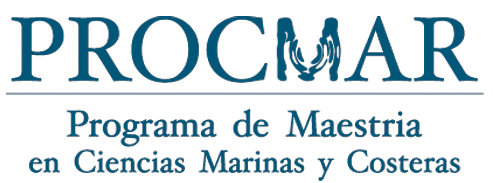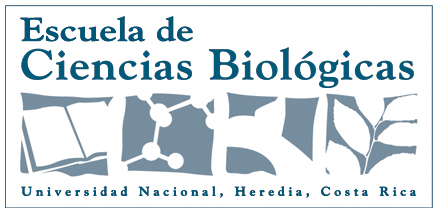|
ISSN: 1659-455X • e-ISSN: 1659-407X REVMAR REVISTA CIENCIAS MARINAS Y COSTERAS
Recepción 11 enero 2022 • Corregido 29 abril 2022 Occurrence of the rough eagle ray Aetomylaeus asperrimus (Chondrichthyes: Myliobatidae) along the north Pacific coast of Costa Rica Presencia de la raya águila de piel áspera Aetomylaeus asperrimus (Chondrichthyes: Myliobatidae) en la costa del Pacífico Norte de Costa Rica Elpis J. Chávez1*, Maike Heidemeyer2,3, Randall Arauz4, Daniel Arauz-Naranjo1, Randall Mora-Vargas3, José Luis Molina-Quirós5 & Sebastián Hernández-Muñoz5,6 ABSTRACT Almost 25% of skates and rays’ information worldwide is insufficient to assess their extinction risk. We reported the first seven confirmed records of the rough eagle ray (Aetomylaeus asperrimus) along the north Pacific coast of Costa Rica. These findings suggest that encounters with this species are rare, possibly associated with oceanographic patterns. More information is needed to make accurate assumptions on the species’ abundance, ecology, and conservation needs. Keywords: Conservation, data deficient, elasmobranchs, range extension, Eastern Tropical Pacific RESUMEN A nivel mundial, casi el 25% de los batoideos carece de información suficiente para evaluar su riesgo de extinción. Se reportan los primeros siete registros confirmados de la raya águila de piel áspera (Aetomylaeus asperrimus), en la costa del Pacífico Norte de Costa Rica. Se sugiere que la presencia de A. asperrimus es rara, posiblemente asociada con patrones oceanográficos. Se necesita más información para poder evaluar la abundancia, la ecología y las necesidades de conservación de la especie. Palabras clave: Conservación, especie con datos deficientes, elasmobranquios, extensión de rango, Pacífico Oriental Tropical The genus Aetomylaeus Garman 1908 is one of the two extant genera (together with Aetobatus) of the eagle ray family Myliobatidae (Last et al. 2016). Once considered a third genus for the family, Pteromylaeus is currently considered a junior synonym of Aetomylaeus (Aschliman, 2014; White, 2014; Last et al. 2016). This genus includes seven extant species, six broadly distributed along the Western Indian Ocean and Indo-West Pacific, and one species (Aetomylaeus asperrimus Gilbert, 1898) reported for the Eastern Pacific (Last et al. 2016; White et al. 2016). The rough eagle ray (A. asperrimus) primarily inhabits demersal soft bottoms in tropical coastal waters, where it presumably feeds on hard-shelled and bottom-dwelling invertebrates (Last et al. 2016). Its distributional range is still unclear and currently derives entirely from country or region-wide taxonomic checklists and identification guides. The species is listed as Data Deficient (DD) under IUCN Red List criteria, because current information is inadequate to assess extinction risk based on distribution and population status (Valenti & Kyne, 2016). The presence of the species had been reported in taxonomic checklists from Mexico (Castro-Aguirre & Espinosa-Pérez, 1996; Eheman et al. 2018), Panama (McEachran & Notarbartol di Sciara, 1995), and Galapagos (Grove & Lavenberg, 1997). Consequently, it was expected to occur from Mexican waters to northern Peru (Castro-Aguirre & Espinosa-Pérez, 1996; Bussing & López, 2009; Espinoza et al. 2018; Robertson & Allen, 2015; Weigmann, 2016; Eheman et al. 2018). However, Panama is the only country where a specimen had been actually described (type specimen: female, 79 cm disc width). Our observations represent the first records for this species in Costa Rica. Sightings of A. asperrimus were video recorded during apnea dive surveys in the Gulf of Santa Elena, specifically at “La Cornuda” (11° 33’ N, 85° 41’ W) in April 2015 and December 2017, and in the Gulf of Papagayo, specifically at “Punta Naranja” (10° 33’ N, 85° 41’ W) in September 2019, both sites located in the northern Nicoya Peninsula (Fig. 1). Additional specimens were opportunistically caught during bull shark (Carcharhinus leucas) fisheries independent surveys in front of the mouth of the Bongo River (9° 44’ N, 85° 14’ W), in the Marine Protected Area of the Caletas-Arío National Wildlife Refuge (NWR) (Fig. 1), Southern Nicoya Peninsula, between March 2017 and August 2019. The fishing gear was rigged to catch bull sharks and consisted of a 250-300 m mainline built with 4 mm braided nylon rope, set at the bottom at ~ 8-12 m depth. Every 6 to 8 m a gangion with a hook was clipped to the mother line. Gangions consisted of 1 m of monofilament line (2 mm) and a 45 cm extension of stainless-steel wire leader, to which circle hooks (no.14 and 15, 10°offset) were attached. Hooks were baited with frozen sardine (Clupeidae) and skipjack tuna (Katsuwonus pelamis Linnaeus, 1758). Rough eagle ray specimens caught were measured (Disc Width, or DW), sexed, and photographed. Species identification was based on morphological characteristics described in the literature (e.g., Last et al. 2016).
Fig. 1. Aetomylaeus asperrimus sighting locations in the north Pacific coast of Costa Rica Fig. 1. Lugares de avistamientos de Aetomylaeus asperrimus en la costa del Pacífico Norte de Costa Rica Seven rough eagle rays were reported along the North Pacific coast of Costa Rica, from April 2015 to August 2019 (Table 1). Three individuals were observed during apnea diving activities in coastal waters of the Gulfs of Santa Elena and Papagayo in April 2015, December 2017, and July 2019. The individuals were observed actively swimming about 5 - 8 m above a sandy and coarse sandy-gravel bottom (Fig. 2). Four additional individuals, two females and two males, were caught and released at the mouth of the Bongo River (Fig. 3). The specimens caught measured between 69-150 cm of DW (Table 1). The morphological identification of the specimens was evident by inspecting the disk from a dorsal view, with its distinctive brownish to greyish coloration, including the distinctive 7-9 white band pattern on the front end of the disk, and numerous white spots, mostly in the back end of the disk (Fig. 2 and 3). Table 1. Aetomylaeus asperrimus specimens reported along the North Pacific coast of Costa Rica Cuadro 1. Individuos de Aetomylaeus asperrimus reportados a lo largo del Pacífico Norte de Costa Rica
*Estimated size from video; DW= Disc Width; F=Female; M= Male; ND= Not determined.
Fig. 2. Dorsal view photographs of two Aetomylaeus asperrimus specimens, recorded at (a) La Cornuda, a rocky reef in the Gulf of Santa Elena, April 2015; and (b) Punta Naranja, a sandy beach in the Gulf of Papagayo, July 2019 Fig. 2. Vista dorsal de dos especímenes de Aetomylaeus asperrimus registrados en (a) “La Cornuda”, un arrecife rocoso en el Golfo de Santa Elena, abril de 2015; y (b) “Punta Naranja”, una playa de arena en el golfo de Papagayo, julio de 2019
Fig. 3. Dorsal view photographs of the three Aetomylaeus asperrimus specimens caught in front of the mouth of the Bongo River during bull shark Carcharhinus leucas research surveys (a) female 90 cm disc width (DW), August 2019; (b) male 69 cm DW, July 2019; (c) male 72 cm DW, July 2019 Fig. 3. Vista dorsal de tres especímenes de Aetomylaeus asperrimus capturados frente a la desembocadura del río Bongo durante los estudios de investigación del tiburón toro Carcharhinus leucas. (a) hembra de 90 cm de ancho de disco (DW), agosto de 2019; b) macho de 69 cm DW, julio de 2019; (c) macho de 72 cm DW, julio de 2019 Assumptions regarding the distribution and habitat use of species listed by the IUCN as DD, such as the rough eagle ray, are often based on information regarding congeneric species (Sievers et al. 2019). Deficient information on this species’ biology, distribution range, and population trends, as well as on the impact of its incidental catch and induced mortality in commercial fisheries, could limit the adequate management and implementation of conservation measures for the species. In Costa Rica, almost half (41%) of the 99 chondrichthyan species reported are cataloged as DD (Espinoza et al. 2018). Further research on these DD species is urgent, especially considering the biological traits that they share as elasmobranchs (long-lived, late maturity, low fecundity) that make them so vulnerable to anthropological impacts (i.e., habitat degradation, trawling, and longline fisheries), particularly coastal elasmobranch species (Dulvy et al. 2014; Espinoza et al. 2018), such as the rough eagle ray. The three locations where the species was reported in Costa Rican waters (Gulf of Santa Elena, Gulf of Papagayo and the mouth of the Bongo River) are located near artisanal fishing communities that target demersal fish with bottom longlines, which considerably increases their rate of interaction with them. Because domestic consumption and trade of ray species is not common in Costa Rica, fishers were persuaded to release incidentally caught rays on-site at no expense to the operation. The presence of a rough eagle ray was confirmed in the Gulf of Santa Elena in April 2015, following a lead provided by a local fisher, who observed “a distinguishably large, brown eagle ray with a huge head” in March of that same year. Due to the numerous white spots present on the back end of the disc, A. asperrimus could be easily confused with the spotted eagle ray Aetobatus laticeps Gill, 1865 (Grove & Lavenberg, 1997). Nevertheless, fishers in this area that target octopus in La Cornuda (Gulf of Santa Elena) all year round claim to have never seen this species before 2015. In addition, the well-known diver Carlos Hiller (resident of the nearby coastal community of Playas del Coco), who provided the video footage of the sighting at Punta Naranja, had never personally seen this species before. These claims suggest that reports of the rough eagle ray in coastal habitats of Costa Rica are rare and are possibly associated with changes in oceanographic patterns such as El Niño-Southern Oscillation (ENSO). ENSO events occur at variable year intervals (usually 2 to 7 years). During these events, the conditions in the Eastern Tropical Pacific change, affecting a variety of marine species and ecosystems (Fiedler, 2002). Although ENSO effects have been documented on corals, birds, sea turtles, and pinnipeds across the Eastern Tropical Pacific (Trillmich & Limberger, 1985; Valle et al. 1987; Saba et al. 2007; Romero-Torres et al. 2020; Martínez-Castillo et al. 2022), the potential impact of ENSO on elasmobranchs has not been sufficiently studied. Further data about the species’ presence through time is required to evaluate this assumption. Nonetheless, more information regarding the local and regional status of the rough eagle ray, along with its distributional range in the Eastern Pacific Ocean, is needed to make more accurate assumptions on the species’ abundance, ecology, and conservation needs in Costa Rica. We would like to acknowledge the efforts of all the volunteers and research assistants that helped us during the bull shark research project, as well as the volunteers and members of Equipo Tora Carey, especially Mathilde Giry and Damien Cordier for providing boat transportation to La Cornuda. Special thanks to fisherman Amado Quirós for the constant support that makes our research activities possible. We also want to thank Carlos Hiller for the recording from Punta Naranja and Roy Saravia for preparing the map. In addition, we would like to express our gratitude to the reviewers whose comments helped us to improve the manuscript. Aschliman, N. C. (2014). Interrelationships of the durophagous stingrays (Batoidea: Myliobatidae). Environ. Biol. Fishes, 97(9), 967-979. https://doi.org/10.1007/s10641-014-0261-8 Bussing, W. A. & López, M. I. (2009). Marine Fish. In I. S. Wehrtmann & J. Cortés (Eds.), Marine biodiversity of Costa Rica, central america (pp. 453-458). Netherlands: Springer. https://doi.org/10.1007/978-1-4020-8278-8_42 Castro-Aguirre, J. L. & Espinosa-Pérez, H. (1996). Catálogo sistemático de las rayas y especies afines de México. Listados Faunísticos de México VII. Ciudad de México: Instituto de Biología-UNAM. Dulvy, N. K., Fowler, S. L., Musick, J. A., Cavanagh, R. D., Kyne, P. M., Harrison, L.R., … & White, W. T. (2014). Extinction risk and conservation of the world’s sharks and rays. Elife, 3:e00590. https://doi.org/10.7554/eLife.00590 Ehemann, N. R., González-González, L. V., Chollet-Villalpando, J. G. & Cruz-Agüero, J. D. L. (2018). Updated checklist of the extant Chondrichthyes within the exclusive economic zone of Mexico. ZooKeys, 774,17-39. https://doi.org/10.3897/zookeys.774.25028 Espinoza, M., Díaz, E., Angulo, A., Hernández, S. & Clarke, T. M. (2018). Chondrichthyan diversity, conservation status, and management challenges in Costa Rica. Front. Mar. Sci. 5, 85. https://doi.org/10.3389/fmars.2018.00085 Fiedler, P. C. (2002). Environmental change in the eastern tropical Pacific Ocean: review of ENSO and decadal variability. Mar. Ecol. Prog. Ser., 244, 265-283. Grove, J. S. & Lavenberg, R. J. (1997). The fishes of the Galápagos Islands. USA: Stanford University Press. Last, P. R., White, W. T., Carvalho, B. S., Stehmann, F. W. & Naylor, G. J. P. (2016). Rays of the world. EE. UU.: CSIRO Publishing. https://doi.org/10.1071/9780643109148 Martínez-Castillo, V., Rodríguez-Troncoso, A. P., Mayfield, A. B., Rodríguez-Zaragoza, F. A., & Cupul-Magaña, A. L. (2022). Coral recovery in the central mexican pacific 20 years after the 1997-1998 El Niño Event. Oceans, 3(1), 48-59. McEachran, J. D. & Notarbartolo di Sciara, G. (1995). Peces Batoideos. In W. Fischer, F. Krupp, W. Schneider, C. Sommer, K. E. Carpenter & V. H. Niem (Eds.), Guía FAO para identificación de especies para los fines de la pesca Pacifico Centro-Oriental (pp. 745-792). Italy: FAO. Robertson, D. R. & Allen, G. R. (2015). Shorefishes of the Tropical Eastern Pacific: online information system. https://biogeodb.stri.si.edu/sftep/en/thefishes/species/265 Romero-Torres, M., Acosta, A., Palacio-Castro, A. M., Treml, E. A., Zapata, F. A., Paz-García, D. A. & Porter, J. W. (2020). Coral reef resilience to thermal stress in the Eastern Tropical Pacific. Glob. Change Biol., 26(7), 3880-3890. https://doi.org/10.1111/gcb.15126 Saba, V. S., Santidrián-Tomillo, P. I. L. A. R., Reina, R. D., Spotila, J. R., Musick, J. A., Evans, D. A. & Paladino, F. V. (2007). The effect of the El Niño Southern Oscillation on the reproductive frequency of eastern Pacific leatherback turtles. J. Appl. Ecol., 44(2), 395-404. https://doi.org/10.1111/j.1365-2664.2007.01276.x Sievers, M., Brown, C. J., Tulloch, V. J., Pearson, R. M., Haig, J. A., Turschwell, M. P. & Connolly, R. M. (2019). The role of vegetated coastal wetlands for marine megafauna conservation. Trends Ecol. Evol., 34(9), 807-817. https://doi.org/10.1016/j.tree.2019.04.004 Trillmich, F. & Limberger, D. (1985). Drastic effects of El Niño on Galapagos pinnipeds. Oecologia, 67,19-22. Valenti, S. V. & Kyne, P. M. (2016). Aetomylaeus asperrimus. the iucn red list of threatened species. http://dx.doi.org/10.2305/IUCN.UK.2016-3.RLTS.T161396A104022431.en Valle, C. A., Cruz, F., Cruz, J. B., Merlen, G. & Coulter, M. C. (1987). The impact of the 1982-1983 El Niño-Southern Oscillation on seabirds in the Galapagos Islands, Ecuador. J. Geophys. Res. Oceans., 92(Issue C13), 437-444. https://doi.org/10.1029/JC092iC13p14437 Weigmann, S. (2016). Annotated checklist of the living sharks, batoids and chimaeras (Chondrichthyes) of the world, with a focus on biogeographical diversity. J. Fish Biol., 88(3), 837-1037. https://doi.org/10.1111/jfb.12874 White, W. T. (2014). A revised generic arrangement for the eagle ray family Myliobatidae, with definitions for the valid genera. Zootaxa, 3860(2), 149-166. https://doi.org/10.11646/zootaxa.3860.2.3 White, W. T., Last, P. R. & Baje, L. (2016). Aetomylaeus caeruleofasciatus, a new species of eagle ray (Myliobatiformes: Myliobatidae) from northern Australia and New Guinea. Ichthyol. Res., 63(1), 94-109. https://doi.org/10.1007/s10228-015-0480-9 Supporting information The supporting video taken from the encounter is available for viewing at: https://youtu.be/a7KKlYGUnSQ 1 Centro Rescate de Especies Marinas Amenazadas (CREMA), Barva, Costa Rica. echavk@gmail.com*; darauz@cremacr.org; ORCID: https://orcid.org/0000-0003-1549-5563; ORCID: https://orcid.org/0000-0001-9496-8298 2 Centro de Investigación en Ciencias Marinas y Limnología (CIMAR), Universidad de Costa Rica, San Pedro, Costa Rica. maike.heidemeyer@ucr.ac.cr; ORCID: https://orcid.org/0000-0001-7547-5631 3 Asociación para la Conservación Integral de Recursos Naturales Equipo Tora Carey (ETC), El Jobo, Guanacaste, Costa Rica. randallmoravargas76@gmail.com; ORCID: https://orcid.org/0000-0003-0209-5755 4 Fins Attached Marine Research and Conservation, Colorado Springs, EE. UU. rarauz@finsattached.org; ORCID: https://orcid.org/0000-0003-4907-0424 5 Biomolecular Laboratory (BIOMOL), Centro de Programas Internacionales y Estudios de Sostenibilidad (CPIES) de la Universidad Veritas, Zapote, Costa Rica. jmolina@veritas.cr; ORCID: https://orcid.org/0000-0001-7163-6004 6 Sala de Colecciones Biológicas, Facultad de Ciencias del Mar, Universidad Católica del Norte, Coquimbo, Chile. shernandez@veritas.cr; ORCID: https://orcid.org/0000-0002-2908-6050 |
/revmar14-1.jpg)
/Fig1_art05.png)
/Fig2_art05.png)
/Fig2_art051.png)
/Fig3_art05.png)




